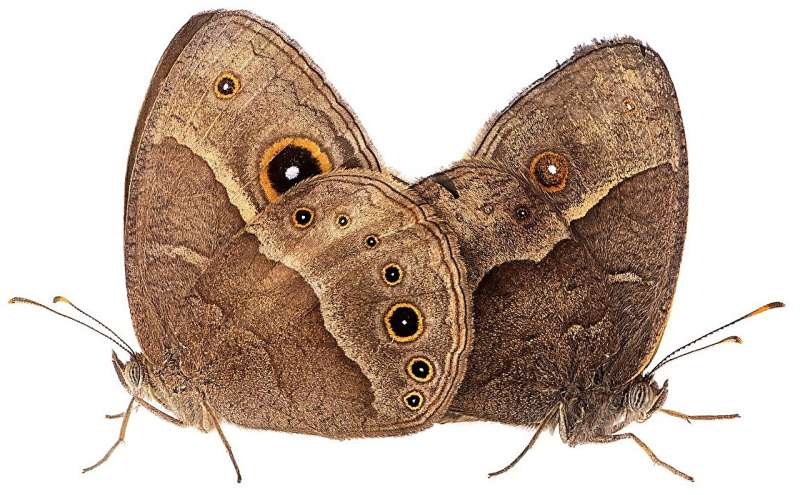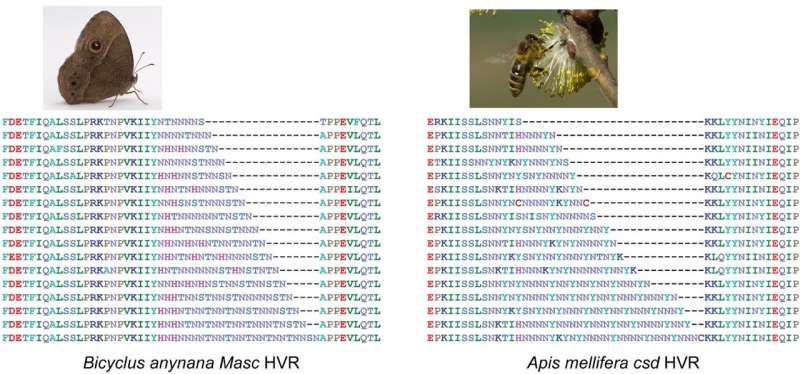This article has been reviewed according to Science X's editorial process and policies. Editors have highlighted the following attributes while ensuring the content's credibility:
fact-checked
peer-reviewed publication
trusted source
proofread
Male or female? Scientists discover the genetic mechanism that determines sex development in butterflies

Scientists of the Biology Centre, Czech Academy of Sciences, in collaboration with University of Liverpool have found the genetic mechanism that determines whether individuals of the butterfly species Bicyclus anynana become male or female.
They also discovered that if individuals with the same variant of the sex-determining gene mate, the embryos will not survive. This can have critical consequences in small butterfly populations with low genetic variation, where mating occurs between related individuals.
This is the first time that scientists have described this mechanism in butterflies and, surprisingly, it resembles a similar mechanism in honey bees. The discovery is published in the journal Science Advances.
The squinting bush brown Bicyclus anynana is native to the African continent. It is often used for genetics research, partly due to its ability to reproduce rapidly and breed relatively easily in laboratory conditions, moreover, its entire genome has already been sequenced.
As revealed by entomologists led by Arjen Van't Hof from the Biology Centre CAS and an international team of collaborators, the sex of this butterfly is regulated by different combinations of variants of a gene called Masculinizer. A single variant leads to female development and two different variants result in male development.
The butterflies die as embryos when two identical variants of Masculinizer are combined but this is very uncommon in natural populations because a huge number of different variants was found. The chance of having two identical variants resulting in embryonic death becomes much higher in strongly declined populations with reduced genetic variation caused by inbreeding.
Many butterfly species are strongly in decline and if other species do have the same mechanism as Bicyclus anynana, it can have serious consequences for critically endangered species.
This sex determination mechanism is the first one found in butterflies and surprisingly resembles that of honeybees belonging to a different insect group more than that of the silkworm which belongs to the same insect order. The same mechanism evolved independently in Bicyclus anynana and honeybees which makes it a clear example of convergent evolution.

Uncovered genetic mechanisms determining sex
Development into two different sexes is among the most significant biological traits, but despite the importance, the underlying genetic mechanisms are not uncovered in most species. The main reason why so much is still unknown is that the mechanisms are extremely diverse.
Lepidoptera, a large insect group consisting of butterflies and moths, have W and Z sex chromosomes instead of X and Y. Females usually have a W and a Z chromosome and males have two Z chromosomes. Sex is determined by the W chromosome in some species, but there are also species in which females do not have a W chromosome.
"These species have different sex-determining mechanisms which are not known yet. The mechanism we discovered in Bicyclus anynana is very different from the W chromosome-dependent mechanism discovered earlier in the silkworm Bombyx mori," say the researchers.
More information: Arjen van't Hof et al, Zygosity-based sex determination in a butterfly drives hypervariability of Masculinizer, Science Advances (2024). DOI: 10.1126/sciadv.adj6979. www.science.org/doi/10.1126/sciadv.adj6979
Journal information: Science Advances
Provided by Biology Centre of the Czech Academy of Sciences


















